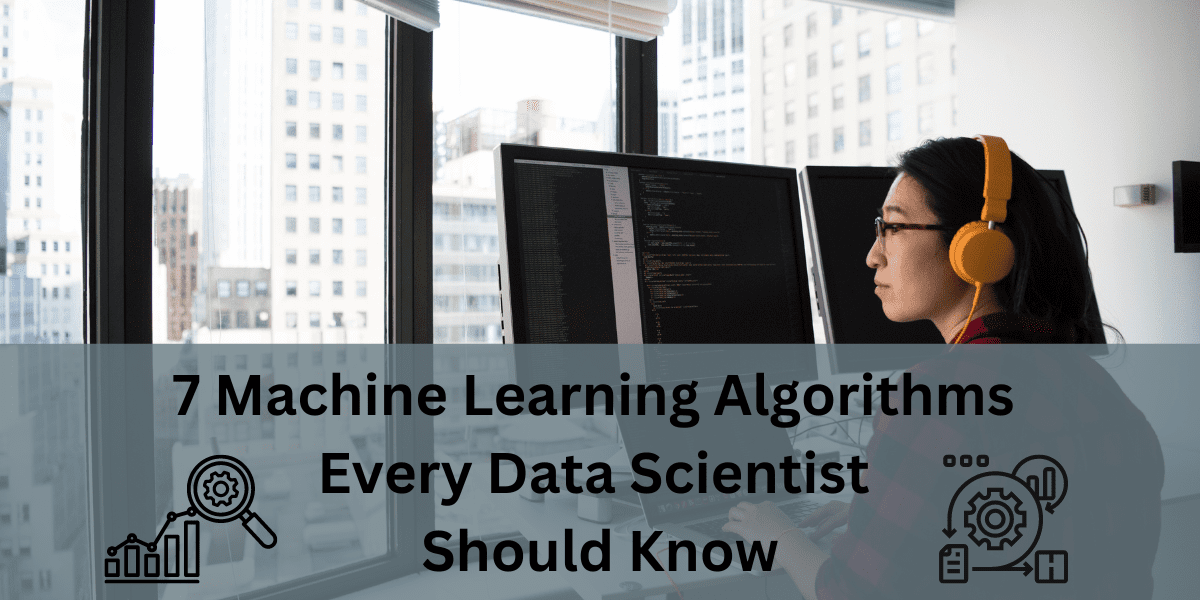
7 Machine Learning Algorithms Every Data Scientist Should Know
Image by Author | Created on Canva
As a data scientist, you should be proficient in SQL and Python. But it can be quite helpful to add machine learning to your toolbox, too.
You may not always use machine learning as a data scientist. But some problems are better solved using machine learning algorithms instead of programming rule-based systems.
This guide covers seven simple yet useful machine learning algorithms. We give a brief overview of the algorithm followed by its working and key considerations. Additionally, we also suggest applications or project ideas which you can try building using the scikit-learn library.
1. Linear Regression
Linear regression helps model the linear relationship between the dependent and one or more independent variables. It’s one of the first algorithms you can add to your toolbox for predicting a continuous target variable from a set of features.
How the Algorithm Works
For a linear regression model involving n predictors, the equation is given by:
Where:
- y is the predicted value
- βi are the model coefficients
- xi are the predictors
The algorithm minimizes the sum of squared residuals to find the optimal values of β:
Where:
- N is the number of observations
- p is the number of predictors
- βi are the coefficients
- xij are the predictor values for the i-th observation and j-th predictor
Key Considerations
- Assumes a linear relationship between features in the dataset.
- Susceptible to multicollinearity and outliers.
A simple regression project on predicting house prices is a good practice.
2. Logistic Regression
Logistic regression is commonly used for binary classification problems but you can use it for multiclass classification as well. The logistic regression model outputs the probability of a given input belonging to a particular class of interest.
How the Algorithm Works
Logistic regression uses the logistic function (sigmoid function) to predict probabilities:

Where βi are the model coefficients. It outputs a probability which can be thresholded to assign class labels.
Key Considerations
- Feature scaling can improve model performance.
- Address class imbalances using techniques like resampling or weighting.
You can use logistic regression for a variety of classification tasks. Classifying whether an email is spam or not can be a simple project you can work on.
3. Decision Trees
Decision trees are intuitive models used for both classification and regression. As the name suggests, decisions are made by splitting the data into branches based on feature values.
How the Algorithm Works
The algorithm selects the feature that best splits the data based on criteria like Gini impurity or entropy. The process continues recursively.
Entropy: Measures the disorder in the dataset:
Gini Impurity: Gini impurity measures the likelihood of misclassifying a chosen point:
The decision tree algorithm selects the feature and split that results in the greatest reduction in impurity (information gain for entropy or Gini Gain for Gini impurity).
Key Considerations
- Simple to interpret but often prone to overfitting.
- Can handle both categorical and numerical data.
You can try training a decision tree on a classification problem you’ve already worked on and check if it’s a better model than logistic regression.
4. Random Forests
Random forest is an ensemble learning method that builds multiple decision trees and averages their predictions for more robust and accurate results.
How the Algorithm Works
By combining bagging (bootstrap aggregation) and random feature selection, it constructs multiple decision trees. Each tree votes on the outcome, and the most voted result becomes the final prediction. The random forest algorithm reduces overfitting by averaging the results across trees.
Key Considerations
- Handles large datasets well and mitigates overfitting.
- Can be computationally more intensive than a single decision tree.
You can apply random forest algorithm for a customer churn prediction project.
5. Support Vector Machines (SVM)
Support Vector Machine or SVM is a classification algorithm. It works by finding the optimal hyperplane—one that maximizes the margin—separating two classes in the feature space.
How the Algorithm Works
The goal is to maximize the margin between the classes using support vectors. The optimization problem is defined as:
where w is the weight vector, xi is the feature vector, and yi is the class label.
Key Considerations
- Can be used for non-linearly separable data if you use the kernel trick. The algorithm is sensitive to the choice of the kernel function.
- Requires significant memory and computational power for large datasets.
You can try using SVM for a simple text classification or spam detection problem.
6. K-Nearest Neighbors (KNN)
K-Nearest Neighbors or KNN is a simple, non-parametric algorithm used for classification and regression by finding the K nearest points to the query instance.
How the Algorithm Works
The algorithm calculates the distance (such as Euclidean) between the query point and all other points in the dataset, then assigns the class of the majority of its neighbors.
Key Considerations
- The choice of k and distance metric can significantly affect performance.
- Sensitive to the curse of dimensionality as distance in high-dimensional spaces.
You can work on a simple classification problem to see how KNN compares to other classification algorithms.
7. K-Means Clustering
K-Means is a common clustering algorithm that partitions the dataset into k clusters based on similarity measured by a distance metric. The data points within a cluster are more similar to each other than to points in other clusters.
How the Algorithm Works
The algorithm iterates over the following two steps:
- Assigning each data point to the nearest cluster centroid.
- Updating centroids based on the mean of the points assigned to them.
K-means algorithm minimizes the sum of squared distances:
where μi is the centroid of cluster Ci.
Key Considerations
- Quite sensitive to the initial random choice of centroids
- The algorithm is also sensitive to outliers.
- Requires defining k ahead of time, which might not always be obvious.
To apply k-means clustering, you can work on customer segmentation and image compression through color quantization.
Wrapping Up
I hope you found this concise guide on machine learning algorithms helpful. This is not an exhaustive list of machine learning algorithms but a good starting point. Once you’re comfortable with these algorithms, you may want to add gradient boosting and the like.
As suggested, you can build simple projects that use these algorithms to better understand how they work. If you’re interested, check out 5 Real-World Machine Learning Projects You Can Build This Weekend.
Happy machine learning!



